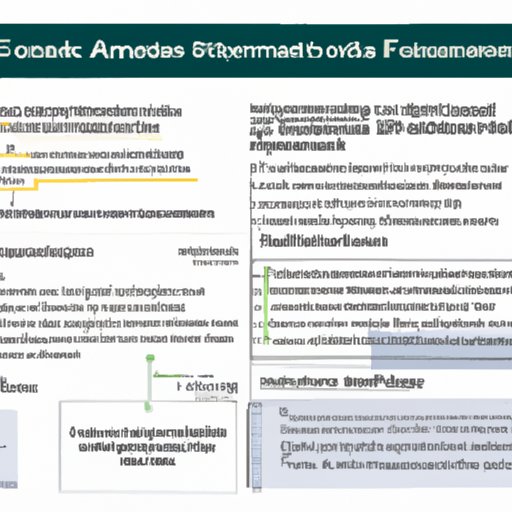Introduction
Financial assets are investments that hold value and can be converted into cash. These assets include stocks, bonds, mutual funds, exchange-traded funds (ETFs), cash equivalents, real estate, and precious metals. In this article, we will explore the different types of financial assets, what to know before you start investing, the pros and cons of investing in financial assets, how to manage them for maximum profit, and the role of financial assets in a balanced portfolio.

Exploring the Different Types of Financial Assets
Stocks and bonds are two of the most common types of financial assets. Stocks represent ownership in a company, while bonds represent debt that the company has issued. Both types of investments come with their own risks and rewards.
Mutual funds are collections of stocks and bonds managed by a professional investor. They provide investors with access to a variety of securities without having to purchase each one individually. Exchange-traded funds (ETFs) are similar to mutual funds but are traded on exchanges instead of through a fund manager.
Cash equivalents are investments that can be quickly converted into cash, such as money market accounts, savings accounts, and certificates of deposit (CDs). These investments are typically low-risk and offer higher yields than checking or savings accounts.
Real estate is another type of financial asset. This includes residential and commercial properties, as well as land and undeveloped land. Investors can purchase real estate outright or invest in real estate investment trusts (REITs), which are companies that own and manage a portfolio of real estate properties.
Precious metals such as gold and silver are becoming increasingly popular as financial assets. These metals have been used as currency for centuries, and they can provide investors with a hedge against inflation and economic uncertainty.
Investing in Financial Assets: What to Know Before You Start
Before investing in any financial asset, it’s important to understand the risks involved. Investing in stocks and bonds carries the risk of losing your principal investment if the value of the security drops. Mutual funds and ETFs also carry the risk of loss, though the risk may be lower because of the diversification of the portfolio.
Diversifying your portfolio is another important factor to consider when investing in financial assets. Diversifying means spreading your investments across different asset classes and sectors. This helps to reduce the overall risk of your portfolio and can help to cushion losses in one area with gains in another.
It’s also important to research potential investment opportunities before investing. Take the time to read up on the company or fund you’re considering and assess the risks and rewards associated with the investment. Additionally, set investment goals so that you have a clear idea of what you want to achieve with your investments.

The Pros and Cons of Investing in Financial Assets
Investing in financial assets has its advantages and disadvantages. One of the biggest advantages is the potential for growth. Investing in stocks and bonds can provide investors with the opportunity to earn returns over time as the value of the securities increase.
Another advantage of investing in financial assets is the potential for tax benefits. Certain investments, such as municipal bonds, offer tax-free income. Additionally, long-term capital gains from investments held for more than one year are taxed at a lower rate than ordinary income.
Investing in financial assets can also provide investors with liquidity. This means that the investments can be easily converted into cash, allowing investors to access their money when they need it. This is particularly beneficial for investors who may need to liquidate their investments quickly due to an emergency or other unforeseen circumstances.
However, there are also some drawbacks to investing in financial assets. One of the biggest risks is market volatility. The value of financial assets can fluctuate significantly, and there is no guarantee that the value of the asset will increase over time. Additionally, investors have little control over the performance of their investments, as factors such as market conditions can affect the price of securities.
Finally, there are fees and expenses associated with investing in financial assets. These can include brokerage fees, management fees, and other costs associated with the buying and selling of securities. These fees and expenses can eat into any potential profits from the investments.
How to Manage Financial Assets for Maximum Profit
Managing financial assets for maximum profit requires developing a strategy and monitoring performance. When developing a strategy, investors should consider their investment goals and create a plan to achieve those goals. This plan should include an assessment of the risks and rewards associated with the investments, as well as an understanding of the current market conditions.
Once the plan is in place, it’s important to monitor the performance of the investments. Regularly review the performance of your investments to ensure that they are meeting your expectations. If the investments are not performing as expected, make adjustments to the strategy or consider selling the investments.
Finally, it’s important to regularly rebalance your portfolio. Rebalancing involves adjusting the mix of investments in your portfolio to maintain the desired level of risk and reward. This can involve selling some investments and purchasing others to ensure that the portfolio remains diversified and meets your investment goals.

Understanding the Role of Financial Assets in a Balanced Portfolio
Having a balanced portfolio is essential for long-term success in investing. A balanced portfolio should include a variety of different asset classes, such as stocks, bonds, mutual funds, cash equivalents, and real estate. Each asset class carries its own risks and rewards, and it’s important to understand these before investing.
Asset allocation strategies can help investors create a diversified portfolio and manage risk. This involves allocating a certain percentage of the portfolio to each asset class based on the investor’s risk tolerance, investment goals, and other factors. For example, a conservative investor may allocate a larger percentage of their portfolio to cash equivalents and bonds, while a more aggressive investor may allocate a larger percentage to stocks.
Building a diversified portfolio is key to achieving long-term success. Investing in a variety of asset classes can help to protect against losses in one sector while still providing the potential for growth. By understanding the risks and rewards associated with each asset class, investors can create a portfolio that is tailored to their individual needs.
Conclusion
Financial assets are investments that hold value and can be converted into cash. These assets include stocks, bonds, mutual funds, ETFs, cash equivalents, real estate, and precious metals. This article explored the different types of financial assets, what to know before you start investing, the pros and cons of investing in financial assets, how to manage them for maximum profit, and the role of financial assets in a balanced portfolio.
When investing in financial assets, it’s important to understand the risks involved and to diversify your portfolio. Additionally, investors should develop a strategy and regularly monitor the performance of their investments. Finally, it’s important to build a diversified portfolio that is tailored to the individual investor’s needs.
Investing in financial assets can be a profitable endeavor, but it’s important to understand the risks and rewards associated with each type of asset. With the right knowledge and strategies, investors can create a portfolio that is tailored to their individual needs and provides the potential for long-term growth.
(Note: Is this article not meeting your expectations? Do you have knowledge or insights to share? Unlock new opportunities and expand your reach by joining our authors team. Click Registration to join us and share your expertise with our readers.)
